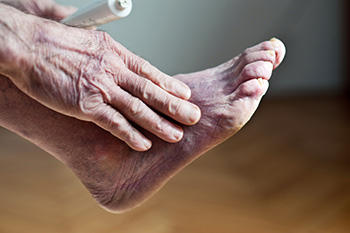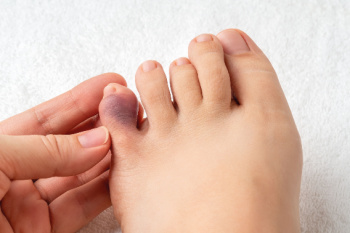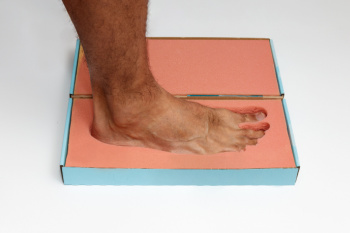Items filtered by date: May 2024
Improving Poor Circulation in the Feet

Circulation refers to the movement of blood throughout the body, delivering oxygen and nutrients to tissues while removing waste products. Poor circulation in the feet can lead to various problems and is often caused by conditions such as peripheral artery disease, diabetes, obesity, and prolonged inactivity. Smoking and a sedentary lifestyle also contribute to reduced blood flow. Symptoms of poor circulation in the feet include numbness, tingling, cold feet, swelling, cramping, and skin discoloration. If left untreated, these issues can lead to more severe complications like ulcers, infections, and, in extreme cases, gangrene. Improving circulation involves lifestyle changes such as regular exercise, maintaining a healthy weight, quitting smoking, and eating a balanced diet rich in fruits, vegetables, and whole grains. Wearing compression stockings and elevating the feet can also help. If you have trouble with poor circulation in your feet, it is suggested that you consult a podiatrist for personalized advice and effective treatment options.
Poor circulation is a serious condition and needs immediate medical attention. If you have any concerns with poor circulation in your feet contact one of our podiatrists of Pocono Foot & Ankle Consultants. our doctors will treat your foot and ankle needs.
Poor Circulation in the Feet
Poor blood circulation in the feet and legs is can be caused by peripheral artery disease (PAD), which is the result of a buildup of plaque in the arteries.
Plaque buildup or atherosclerosis results from excess calcium and cholesterol in the bloodstream. This can restrict the amount of blood which can flow through the arteries. Poor blood circulation in the feet and legs are sometimes caused by inflammation in the blood vessels, known as vasculitis.
Causes
Lack of oxygen and oxygen from poor blood circulation restricts muscle growth and development. It can also cause:
- Muscle pain, stiffness, or weakness
- Numbness or cramping in the legs
- Skin discoloration
- Slower nail & hair growth
- Erectile dysfunction
Those who have diabetes or smoke are at greatest risk for poor circulation, as are those who are over 50. If you have poor circulation in the feet and legs it may be caused by PAD and is important to make changes to your lifestyle in order to reduce risk of getting a heart attack or stroke. Exercise and maintaining a healthy lifestyle will dramatically improve conditions.
As always, see a podiatrist as he or she will assist in finding a regimen that suits you. A podiatrist can also prescribe you any needed medication.
If you have any questions please feel free to contact our offices located in Stroudsburg, Nazareth, and Easton, PA . We offer the newest diagnostic and treatment technologies for all your foot and ankle needs.
Causes and Symptoms of Broken Toes

Broken toes, though often perceived as minor injuries, can cause significant discomfort and inconvenience. Common causes include trauma from stubbing or dropping heavy objects on the toes, as well as sports-related injuries and accidents. Symptoms of a broken toe typically include pain, swelling, bruising, and difficulty bearing weight on the affected foot. In severe cases, the toe may appear misaligned or visibly deformed. Unlike more complex fractures, diagnosing a broken toe may not always require imaging tests. However, seeking medical attention from a podiatrist is advisable to confirm the diagnosis and rule out any complications. Treatment for broken toes typically involves rest, elevation, and immobilization to promote healing and alleviate pain. In some instances, a podiatrist may recommend buddy taping or wearing a splint or walking boot to stabilize the toe during recovery. Having a broken toe can negatively impact daily activities. If you have broken your toe, it is suggested that you seek advice about proper treatment from a podiatrist as quickly as possible to avoid potential complications in healing.
Broken toes may cause a lot of pain and should be treated as soon as possible. If you have any concerns about your feet, contact one of our podiatrists from Pocono Foot & Ankle Consultants. our doctors will treat your foot and ankle needs.
What Is a Broken Toe?
A broken toe occurs when one or more of the toe bones of the foot are broken after an injury. Injuries such as stubbing your toe or dropping a heavy object on it may cause a toe fracture.
Symptoms of a Broken Toe
- Swelling
- Pain (with/without wearing shoes)
- Stiffness
- Nail Injury
Although the injured toe should be monitored daily, it is especially important to have a podiatrist look at your toe if you have severe symptoms. Some of these symptoms include worsening or new pain that is not relieved with medication, sores, redness, or open wounds near the toe.
If you have any questions, please feel free to contact our offices located in Stroudsburg, Nazareth, and Easton, PA . We offer the newest diagnostic and treatment technologies for all your foot care needs.
Help for Non-Healing Diabetic Foot Ulcers

Non-healing foot ulcers in diabetic patients are influenced by a myriad of factors, including the wound environment, the patient's general health, and the medications they are taking. A compromised wound environment, often characterized by high bacterial load, excess moisture, or inadequate blood supply due to peripheral arterial disease, can impede healing. Additionally, the patient's overall health status plays a significant role, with conditions like obesity, smoking, and immune system deficiencies hindering the body's ability to repair tissues. Medications such as corticosteroids and certain chemotherapeutic agents may also interfere with wound healing processes. Addressing these multifaceted challenges requires a comprehensive approach, encompassing wound debridement, infection control, and optimizing the patient's general health through lifestyle modifications and medication adjustments. If you suffer from diabetic foot ulcers, it is strongly suggested that you are under a podiatrist to enhance healing outcomes and reduce the risk of serious complications.
Wound care is an important part in dealing with diabetes. If you have diabetes and a foot wound or would like more information about wound care for diabetics, consult with one of our podiatrists from Pocono Foot & Ankle Consultants. our doctors will assess your condition and provide you with quality foot and ankle treatment.
What Is Wound Care?
Wound care is the practice of taking proper care of a wound. This can range from the smallest to the largest of wounds. While everyone can benefit from proper wound care, it is much more important for diabetics. Diabetics often suffer from poor blood circulation which causes wounds to heal much slower than they would in a non-diabetic.
What Is the Importance of Wound Care?
While it may not seem apparent with small ulcers on the foot, for diabetics, any size ulcer can become infected. Diabetics often also suffer from neuropathy, or nerve loss. This means they might not even feel when they have an ulcer on their foot. If the wound becomes severely infected, amputation may be necessary. Therefore, it is of the upmost importance to properly care for any and all foot wounds.
How to Care for Wounds
The best way to care for foot wounds is to prevent them. For diabetics, this means daily inspections of the feet for any signs of abnormalities or ulcers. It is also recommended to see a podiatrist several times a year for a foot inspection. If you do have an ulcer, run the wound under water to clear dirt from the wound; then apply antibiotic ointment to the wound and cover with a bandage. Bandages should be changed daily and keeping pressure off the wound is smart. It is advised to see a podiatrist, who can keep an eye on it.
If you have any questions, please feel free to contact our offices located in Stroudsburg, Nazareth, and Easton, PA . We offer the newest diagnostic and treatment technologies for all your foot care needs.
How Custom Orthotics Can Help Arthritis Pain

Arthritis, whether rheumatoid or osteoarthritis, can significantly impair one's quality of life, particularly when it affects the feet. Constant foot pain can hinder mobility, limit activities, and lead to physical and emotional challenges. However, custom-made orthotics can help those grappling with arthritis-related foot discomfort. Orthotics are tailor-made shoe inserts designed to alleviate pressure on specific areas of the foot, redistributing weight and promoting proper alignment. By providing support and cushioning, orthotics reduce pain and discomfort, allowing individuals to move more freely and engage in daily activities. Moreover, orthotics can help reduce the need for pain medication, offering a non-invasive alternative for managing arthritis symptoms. By improving gait and reducing strain on joints, orthotics can also play a significant role in preventing the progression of arthritis, helping individuals maintain their mobility and independence for longer. If you suffer from arthritic symptoms of the feet, it is suggested that you schedule an appointment with a podiatrist for relief options.
If you are having discomfort in your feet and would like to try orthotics, contact one of our podiatrists from Pocono Foot & Ankle Consultants. our doctors can provide the care you need to keep you pain-free and on your feet.
What Are Orthotics?
Orthotics are inserts you can place into your shoes to help with a variety of foot problems such as flat feet or foot pain. Orthotics provide relief and comfort for minor foot and heel pain but can’t correct serious biomechanical problems in your feet.
Over-the-Counter Inserts
Orthotics come in a wide variety of over-the-counter inserts that are used to treat foot pain, heel pain, and minor problems. For example, arch supports can be inserted into your shoes to help correct overarched or flat feet, while gel insoles are often used because they provide comfort and relief from foot and heel pain by alleviating pressure.
Prescription Orthotics
If over-the-counter inserts don’t work for you or if you have a more severe foot concern, it is possible to have your podiatrist prescribe custom orthotics. These high-quality inserts are designed to treat problems such as abnormal motion, plantar fasciitis, and severe forms of heel pain. They can even be used to help patients suffering from diabetes by treating foot ulcers and painful calluses and are usually molded to your feet individually, which allows them to provide full support and comfort.
If you are experiencing minor to severe foot or heel pain, it’s recommended to speak with your podiatrist about the possibilities of using orthotics. A podiatrist can determine which type of orthotic is right for you and allow you to take the first steps towards being pain-free.
If you have any questions please contact our offices located in Stroudsburg, Nazareth, and Easton, PA . We offer the newest diagnostic and treatment technologies for all your foot and ankle needs.




